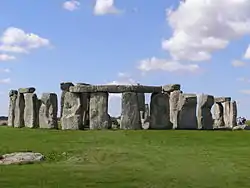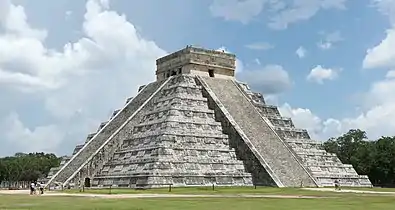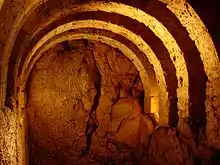Archaeoacoustics
Archaeoacoustics is the use of acoustical study as a methodological approach within the field of archaeology. Archaeoacoustics examines the acoustics of archaeological sites and artifacts. It is an interdisciplinary field that includes archaeology, ethnomusicology, acoustics and digital modelling, and is part of the wider field of music archaeology, with a particular interest in prehistoric music. Since many cultures explored through archaeology were focused on the oral and therefore the aural, researchers believe that studying the sonic nature of archaeological sites and artifacts may reveal new information on the civilizations scrutinized.[1]
| Anthropology |
|---|
 |
Notable work
Disciplinary methodology
Damian Murphy of the University of York has studied measurement techniques in acoustic archaeology.[2]
Ancient sites

In 1999, Aaron Watson undertook work on the acoustics of numerous archaeological sites, including that of Stonehenge, investigated numerous chamber tombs and other stone circles.[3] Rupert Till (Huddersfield) and Bruno Fazenda (Salford) also explored Stonehenge's acoustics.[4][5][6][7][8] In the October 2011 edition of the Journal of the Acoustical Society of America, Steven Waller argued that acoustics interference patterns were used to design the blue print of Stonehenge.[9]
Miriam Kolar and colleagues (Stanford) studied various spatial and perceptual attributes of Chavín de Huantar. They identified within the site held the same resonance produced by pututu shells (also used as instruments in the Chavín culture).[10][9]

Scientific research led since 1998 suggests that the Kukulkan pyramid in Chichen Itza mimics the chirping sound of the quetzal bird when humans clap their hands around it. The researchers argue that this phenomenon is not accidental, that the builders of this pyramid felt divinely rewarded by the echoing effect of this structure. Technically, the clapping noise rings out and scatters against the temple's high and narrow limestone steps, producing a chirp-like tone that declines in frequency.[11][12]
Lithophony
Archaeologist Paul Devereux's work (2001) has looked at ringing rocks, Avebury and various other subjects, that he details in his book Stone Age Soundtracks.[13]
Ian Cross of University of Cambridge has explored lithoacoustics, the use of stones as musical instruments.[14]
Archaeologist Cornelia Kleinitz has studied the sound of a rock gongs in Sudan with Rupert Till and Brenda Baker.[15]
Art and acoustics
Iegor Reznikoff and Michel Dauvois studied the prehistoric painted caves of France, and found links between the artworks' positioning and acoustic effects.[16] An AHRC project headed by Rupert Till of Huddersfield University, Chris Scarre of Durham University and Bruno Fazenda of Salford University, studies similar relationships in the prehistoric painted caves in northern Spain.[17]
Archaeologists Margarita Díaz-Andreu, Carlos García Benito and Tommaso Mattioli have undertaken work on rock art landscapes in Italy, France and Spain, paying particular attention to echolocation and augmented audibility of distant sounds that is experienced in some rock art sites.[18][19][20][21][22]
Greek and Roman structures

Steven Waller has also studied the links between rock art and sound. Panagiotis Karampatzakis and Vasilios Zafranas investigated the Acoustic Properties of the Necromanteion of Acheron,[23] Aristoxenus acoustic vases,[24] and the evolution of acoustics in the ancient Greek and Roman odea.[25]
Study groups
The International Study Group on Music Archaeology (ISGMA), which includes archaeoacoustical work, is a pool of researchers devoted to the field of music archaeology. The study group is hosted at the Orient Department of the German Archaeological Institute Berlin (DAI, Deutsches Archäologisches Institut, Orient-Abteilung) and the Department for Ethnomusicology at the Ethnological Museum of Berlin (Ethnologisches Museum Berlin, SMB SPK, Abteilung Musikethnologie, Medien-Technik und Berliner Phonogramm-Archiv). The ISGMA comprises research methods of musicological and anthropological disciplines (archaeology, organology, acoustics, music iconology, philology, ethnohistory, and ethnomusicology).
The Acoustics and Music of British Prehistory Research Network was funded by the Arts and Humanities Research Council and Engineering and Physical Sciences Research Council, led by Rupert Till and Chris Scarre, as well as Professor Jian Kang of Sheffield University's Department of Architecture. It has a list of researchers working in the field, and links to many other relevant sites. An e-mail list has been discussing the subject since 2002 and was set up as a result of the First Pan-American/Iberian Meeting on Acoustics by Victor Reijs.[26]
Based in the US, the OTS Foundation has conducted several international conferences specifically on Archaeoacoustics, with a focus on the human experience of sound in ancient ritual and ceremonial spaces. The published papers represent a broader multidisciplinary study and include input from the realms of archaeology, architecture, acoustic engineering, rock art, and psycho-acoustics, as well as reports of field work from Gobekli Tepe and Southern Turkey, Malta, and elsewhere around the world.
The European Music Archeology Project is a multi-million euro project to recreate ancient instruments and their sounds, and also the environments in which they would have been played.[27]
Past interpretations controversy
An early interpretation of the idea of archaeoacoustics was that it explored acoustic phenomena encoded in ancient artifacts. For instance, the idea that a pot or vase could be "read" like a gramophone record or phonograph cylinder for messages from the past, sounds encoded into the turning clay as the pot was thrown. There is little evidence to support such ideas, and there are few publications claiming that this is the case. In comparison, the more contemporary approach to the field now has many publications and a growing significance. This earlier approach was first raised in the 6 February 1969 issue of New Scientist magazine, where it was discussed in David E. H. Jones's light-hearted "Daedalus" column. He wrote:
[A] trowel, like any flat plate, must vibrate in response to sound: thus, drawn over the wet surface by the singing plasterer, it must emboss a gramophone-type recording of his song in the plaster. Once the surface is dry, it may be played back.
— Jones, 1982[28]
Jones subsequently received a letter from one Richard G. Woodbridge III who claimed to have already been working on the idea and said that he had sent a paper on the subject to the journal Nature. The paper never appeared in Nature, but the August 1969 edition of the journal Proceedings of the IEEE printed a letter from Woodbridge entitled "Acoustic Recordings from Antiquity". In this communication, the author stated that he wished to call attention to the potential of what he called "Acoustic Archaeology" and to record some early experiments in the field. He then described his experiments with making clay pots and oil paintings from which sound could then be replayed, using a conventional record player cartridge connected directly to a set of headphones. He claimed to have extracted the hum of the potter's wheel from the grooves of a pot, and the word "blue" from an analysis of patch of blue color in a painting.[29]
In 1993, archeology professor Paul Åström and acoustics professor Mendel Kleiner performed similar experiments in Gothenburg, and reported that they could recover some sounds.[30]
An episode of MythBusters explored the idea: Episode 62: Killer Cable Snaps, Pottery Record found that while some generic acoustic phenomena can be found on pottery, it is unlikely that any discernible sounds (like someone talking) could be recorded on the pots unless ancient people had the technical knowledge to deliberately put the sounds on the artifacts.[31]
In 1902, Charles Sanders Peirce wrote: "Give science only a hundred more centuries of increase in geometrical progression, and she may be expected to find that the sound waves of Aristotle's voice have somehow recorded themselves."[32]
In popular culture
- Nigel Kneale's 1972 BBC television play The Stone Tape helped to popularize the term 'stone tape theory'.
- Arthur C. Clarke discussed the idea at a NASA conference on the future of technology in the early 1970s.
- An episode of Mysteryquest on History called Stonehenge featured Rupert Till and Bruno Fazenda conducting acoustic tests at Stonehenge and at the Maryhill Monument, a full-sized replica of Stonehenge in the USA.
- Gregory Benford's 1979 short story "Time Shards" concerns a researcher who recovers thousand-year-old sound from a piece of pottery thrown on a wheel and inscribed with a fine wire as it spun. The sound is then analyzed to reveal conversations between the potter and his assistant in Middle English.
- Rudy Rucker's 1981 short story "Buzz" includes a small section of audio recovered from ancient Egyptian pottery.
- A 2000 episode of The X-Files, "Hollywood A.D.", features "The Lazarus Bowl", a mythical piece of pottery reputed to have recorded on it the words that Jesus Christ spoke when he raised Lazarus from the dead.
- In the 1996 game Amber: Journeys Beyond, this phenomenon is referred to as 'stone tape theory' and a key part of the game's plot.
- CSI: Crime Scene Investigation used this in 2005 episode "Committed", where an inmate's conversation is partially recorded on a clay jar.
- In the first-season episode of Fringe entitled "The Road Not Taken", an electron microscope is used to reproduce sounds captured on a partially melted window.
References
- Till, Rupert (2014). 'Sound Archaeology: An Interdisciplinary Perspective', in Archaeoacoustics: The Archaeology of Sound, Linda Einix (ed). Malta: OTS Foundation. ISBN 978-1497591264.
- Damian T. Murphy (September 2006). "Archaeological acoustic space measurement for convolution reverberation and auralization applications". CiteSeerX 10.1.1.422.5265. Cite journal requires
|journal=(help) - Watson, A. and Keating, D. 1999. Architecture and sound: an acoustic analysis of megalithic monuments in prehistoric Britain. Antiquity 73, 325-36.
- Fazenda, B.M., 2013. The acoustics of Stonehenge. Acoustics Bulletin,38(1), pp.32-37.
- Fazenda, B. and Drumm, I., Recreating The Sound Of Stonehenge Acoustics Of Ancient Theatres, The Acoustics of Ancient Theatres Conference Patras, September 18-21, 2011
- Till, Rupert (2011-01-20). "Songs of the Stones: An Investigation into the Acoustic History and Culture of Stonehenge". IASPM@Journal. 1 (2): 1–18. doi:10.5429/2079-3871(2010)v1i2.10en. ISSN 2079-3871.
- Till, Rupert (2010). "Songs of the Stones: The Acoustics of Stonehenge, in BAR 504 2009: The Sounds of Stonehenge Centre for the History of Music in Britain, the Empire and the Commonwealth. CHOMBEC Working Papers No. 1 edited by Stephen Canfield. pp. 17-44". Songs of the stones: the acoustics of Stonehenge. Archaeopress: Oxford. Retrieved 29 September 2016.
- Fazenda, B. and Drumm, I., 2013. Recreating the sound of Stonehenge. Acta Acustica united with Acustica, 99(1), pp.110-117.
- Nadia Drake, Archaeoacoustics: Tantalizing, but fantastical, Sciencenews.org, 17 February 2012
- "Chavín de Huántar Archaeological Acoustics Project: Stanford Ph.D. Dissertation in Archaeoacoustics". ccrma.stanford.edu. Retrieved 2017-09-04.
- Jennie Cohen, Did the Maya Build Chirping Pyramids?, History.com, 17 November 2010
- David Lubman, Archaeological acoustic study of chirped echo from the Mayan pyramid at Chichen Itza, in the Yucatan Region of Mexico ... Is this the world's oldest known sound recording?, Acoustics.org, 13 October 1998
- Paul Devereux and Tony Richardson, 'Stone Age Soundtracks: The Acoustic Archaeology of Ancient Sites', Vega, 2001.
- "Faculty of Music - Dr Ian Cross". www.mus.cam.ac.uk. Archived from the original on 2013-08-23. Retrieved 2017-09-04.
- Till, Rupert; Cornelia Kleinitz; Brenda Baker (January 2015). "Archaeology and acoustics of rock gongs in the ASU BONE concession above the Fourth Nile Cataract, Sudan: A preliminary report". ResearchGate. Sudan Archaeological Research Society. Retrieved 29 September 2016.
- Iegor Reznikoff and Michel Dauvois, Bulletin de Ia Societe Prehistonque Francaise (85. 238-246; 1988).
- "Songs of the Caves". Songs of the Caves. Retrieved 2017-09-04.
- Díaz-Andreu, M. and García Benito, C. 2012. Acoustics and Levantine Rock Art: Auditory Perceptions in La Valltorta Gorge (Spain). Journal of Archaeological Science 39: 3591-3599.
- Díaz-Andreu, M. and García Benito, C. 2015. Acoustic rock art landscapes: a comparison between the acoustics of three Levantine rock art areas in Mediterranean Spain. Rock Art Research 32: 46-62.
- Díaz-Andreu, M., García Atiénzar, G., García Benito, C. and Mattioli, T. 2017. Do you hear what I see? Analyzing visuality and audibility through alternative methods in the rock art landscape of the Alicante mountains. Journal of Anthropological Research 73: 181-213.
- Mattioli, T. and Díaz-Andreu, M. 2017. Hearing rock art landscapes. A survey of the acoustical perception in the Sierra de San Serván area in Extremadura (Spain). Time and Mind 10: 81-96
- Mattioli, T. and Díaz-Andreu, M. 2017. Mattioli, T., Farina, A., Armelloni, E., Hameau, P. and Díaz-Andreu, M. 2017. Echoing landscapes: echolocation and the placement of rock art in the Central Mediterranean. Journal of Archaeological Science 83: 12-25
- "Aristotle University of Thessaloniki - Psifiothiki: Record#124480: Did Hades accept visitors? The acoustical properties of the underground crypt of the Acheron Nekromanteion, Preveza, Greece". Archived from the original on 2013-10-20. Retrieved 2017-09-04.
- "Warning - Aristotle University of Thessaloniki - Psifiothiki" (PDF). invenio.lib.auth.gr. Retrieved 2017-09-04.
- "Aristotle University of Thessaloniki - Psifiothiki: Record#127565: An approach into the acoustic evolution of ancient Odea". Archived from the original on 2013-10-20. Retrieved 2017-09-04.
- Reijs, V.M.M., MegaSound: Sound in Irish megalithic buildings, First Pan-American/Iberian Meeting on Acoustics, 2002, Session 3aAA2, page 2284.
- ” Alex Marshall, Music of the ages, Wired, August 2016, p.111
- David E.H., Jones (1982), The Inventions of Daedalus: A Compendium of Plausible Schemes, W.H. Freeman & Company, ISBN 978-0-7167-1412-5
- Woodbridge, R.G. (August 1969), "Acoustic Recordings from Antiquity", Proceedings of the IEEE, 57 (8): 1465–1466, doi:10.1109/PROC.1969.7314
- Kleiner, Mendel; Åström, Paul (1993), "The Brittle Sound of Ceramics - Can Vases Speak?", Archeology and Natural Science, 1: 66–72
- Ancient Voices Recorded Onto Pottery, Discovery.com, 2006
- Peirce, C. S. (manuscript circa 1902), "Reason's Rules," Collected Papers vol. 5 (1934), paragraph 542. The quote is from near the end.